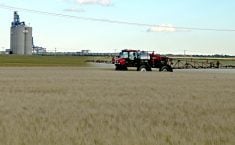Labels on the two main fungicides used to suppress fusarium head blight, Bayer’s Folicur and Proline, recommend double fore-aft nozzles or twin spray nozzles.
Agriculture Canada researcher Tom Wolf agrees that tip technology is important, but emphasizes that timing is most important.
“Doubling the deposit doesn’t necessarily double the efficacy,” Wolf said.
“Efficacy depends on many other factors: suitability of the active ingredient for the job, susceptibility of the cultivar, disease pressure and most of all, timing.”
Read Also

House ag committee to undertake several studies
The House of Commons standing agriculture committee has set its agenda for the coming months. Members began the fall sitting with a two-hour update on international trade
Folicur 432F is tebuconazole 432 grams per litre formulated as a flowable liquid. It’s a Group 3 fungicide for head blight suppression in spring wheat and durum.
It should be applied when 75 percent of the wheat heads on the main stem are fully emerged to when 50 percent of the heads on the main stem are in flower.
Proline 480 SC is prothioconazole formulated as a suspension concentrate. It’s a Group 3 fungicide used to suppress head blight in wheat and barley.
It should be applied on barley when 70 to 100 percent of heads on main stem are fully emerged to three days after full head emergence.
Apply on wheat when at least 75 percent of heads on the main stem are fully emerged to when 50 percent of heads on the main stem are in flower.
Caramba is a new systemic triazole from BASF and will be reaching the market later this year. See page 65 for more information.
Bravo 500 from Syngenta is a Group M fungicide, but is seldom used against head blight.

















